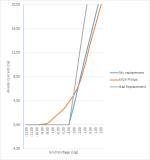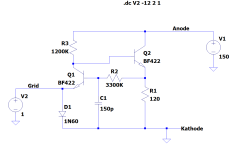Hello everyone on this forum,
I recently received a Philips 2531 radio.
But unfortunately all the tubes where missing.
So, I was searching for the E424, E442 and C443.
But some of these tubes are hard to find here.
But I really wanted to use the radio.
Via a Dutch forum I was instructed on how to make a C443 with a PL95 tube.
I tested this substitute in another radio of mine, and it works.
That brings me to the problem I have right now.
I am trying to make a replacement for a E424 tube.
And I found a page were someone tried this with 2 BF422.
When I was testing this circuit, I found out that it doesn’t match the curve of an E424.
So, I made some changes to the design, and the linear part of the curve matches quite good now.
I am curious, if there is anyone who has a suggestion about how to get het curve more like an original E424.
I would like to have a rounder curve at the bottom, so that not only the linear part matches the E424 transfer characteristics.
*note
I also tested this E424 substitute in another radio. And it works.
Because in that radio the grid is biased with 0 Volt.
So, it than operates in the linear part of the characteristics.
This E424 tube is mostly used as preamplifier and detector in Philips radios.
Here are my test results and my schematics.
If you have any tips or tricks for this replacement, I am happy to hear about them!
I recently received a Philips 2531 radio.
But unfortunately all the tubes where missing.
So, I was searching for the E424, E442 and C443.
But some of these tubes are hard to find here.
But I really wanted to use the radio.
Via a Dutch forum I was instructed on how to make a C443 with a PL95 tube.
I tested this substitute in another radio of mine, and it works.
That brings me to the problem I have right now.
I am trying to make a replacement for a E424 tube.
And I found a page were someone tried this with 2 BF422.
When I was testing this circuit, I found out that it doesn’t match the curve of an E424.
So, I made some changes to the design, and the linear part of the curve matches quite good now.
I am curious, if there is anyone who has a suggestion about how to get het curve more like an original E424.
I would like to have a rounder curve at the bottom, so that not only the linear part matches the E424 transfer characteristics.
*note
I also tested this E424 substitute in another radio. And it works.
Because in that radio the grid is biased with 0 Volt.
So, it than operates in the linear part of the characteristics.
This E424 tube is mostly used as preamplifier and detector in Philips radios.
Here are my test results and my schematics.
If you have any tips or tricks for this replacement, I am happy to hear about them!
Attachments
J-fets tend to have shaper characteristics than tubes. What about taking a more modern tube and modifying the base or the socket to take this? A 6J5 might not be a bad match if you can adjust the heater voltage and put a silicon diode in the cathode lead. There may be much better suggestions.
Last edited:

